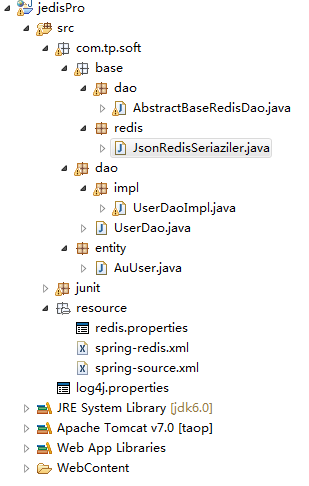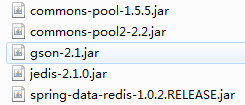最近在研究redis也结合了许多网上的资料分享给大家,有些不足的还望大家多补充提点,下面直接进入主题。
结构图:

几个redis的核心jar,spring的一些jar自行导入

接下来开始配置项目:
1、配置文件
redis.properties
redis.host = 192.168.76.76 redis.port = 6379 redis.pass = admin redis.maxIdle = 200 redis.maxActive = 1024 redis.maxWait = 10000 redis.testOnBorrow = true
spring-redis.xml
<?xml version="1.0" encoding="UTF-8"?> <beans xmlns="http://www.springframework.org/schema/beans" xmlns:xsi="http://www.w3.org/2001/XMLSchema-instance" xmlns:aop="http://www.springframework.org/schema/aop" xmlns:context="http://www.springframework.org/schema/context" xmlns:tx="http://www.springframework.org/schema/tx" xmlns:jee="http://www.springframework.org/schema/jee" xmlns:jdbc="http://www.springframework.org/schema/jdbc" xmlns:cache="http://www.springframework.org/schema/cache" xmlns:jaxws="http://cxf.apache.org/jaxws" xmlns:jaxrs="http://cxf.apache.org/jaxrs" xsi:schemaLocation="http://www.springframework.org/schema/beans http://www.springframework.org/schema/beans/spring-beans.xsd http://www.springframework.org/schema/tx http://www.springframework.org/schema/tx/spring-tx.xsd http://www.springframework.org/schema/context http://www.springframework.org/schema/context/spring-context.xsd http://www.springframework.org/schema/aop http://www.springframework.org/schema/aop/spring-aop.xsd http://www.springframework.org/schema/jee http://www.springframework.org/schema/jee/spring-jee-3.1.xsd http://www.springframework.org/schema/jdbc http://www.springframework.org/schema/jdbc/spring-jdbc-3.1.xsd http://www.springframework.org/schema/cache http://www.springframework.org/schema/cache/spring-cache-3.2.xsd http://cxf.apache.org/jaxws http://cxf.apache.org/schemas/jaxws.xsd http://cxf.apache.org/jaxrs http://cxf.apache.org/schemas/jaxrs.xsd" default-autowire="byName" > <!-- 引入配置文件 --> <context:property-placeholder location="classpath:/resource/redis.properties"/> <!-- 连接池基本参数配置,类似数据库连接池 --> <bean id="poolConfig" class="redis.clients.jedis.JedisPoolConfig"> <property name="maxIdle" value="${redis.maxIdle}" /> <property name="testOnBorrow" value="${redis.testOnBorrow}"/> </bean> <!-- 连接池配置,类似数据库连接池 --> <bean id="connectionFactory" class="org.springframework.data.redis.connection.jedis.JedisConnectionFactory" > <property name="hostName" value="${redis.host}"></property> <property name="port" value="${redis.port}"></property> <property name="password" value="${redis.pass}"></property> <property name="poolConfig" ref="poolConfig"></property> </bean> <!-- 调用连接池工厂配置 --> <bean id="redisTemplate" class=" org.springframework.data.redis.core.RedisTemplate"> <property name="connectionFactory" ref="connectionFactory"></property> <!-- 自定义json序列化存储 --> <!-- <property name="defaultSerializer"> <bean class="org.springframework.data.redis.serializer.StringRedisSerializer"/> </property> --> <!-- 如果不配置Serializer,那么存储的时候智能使用String,如果用User类型存储,那么会提示错误User can't cast to String!!! --> <property name="keySerializer"> <bean class="org.springframework.data.redis.serializer.StringRedisSerializer" /> </property> <property name="valueSerializer"> <bean class="org.springframework.data.redis.serializer.JdkSerializationRedisSerializer" /> </property> </bean> </beans>
spring-source.xml
<?xml version="1.0" encoding="UTF-8"?> <beans xmlns="http://www.springframework.org/schema/beans" xmlns:xsi="http://www.w3.org/2001/XMLSchema-instance" xmlns:aop="http://www.springframework.org/schema/aop" xmlns:context="http://www.springframework.org/schema/context" xmlns:tx="http://www.springframework.org/schema/tx" xmlns:jee="http://www.springframework.org/schema/jee" xmlns:jdbc="http://www.springframework.org/schema/jdbc" xmlns:cache="http://www.springframework.org/schema/cache" xmlns:jaxws="http://cxf.apache.org/jaxws" xmlns:jaxrs="http://cxf.apache.org/jaxrs" xsi:schemaLocation="http://www.springframework.org/schema/beans http://www.springframework.org/schema/beans/spring-beans.xsd http://www.springframework.org/schema/tx http://www.springframework.org/schema/tx/spring-tx.xsd http://www.springframework.org/schema/context http://www.springframework.org/schema/context/spring-context.xsd http://www.springframework.org/schema/aop http://www.springframework.org/schema/aop/spring-aop.xsd http://www.springframework.org/schema/jee http://www.springframework.org/schema/jee/spring-jee-3.1.xsd http://www.springframework.org/schema/jdbc http://www.springframework.org/schema/jdbc/spring-jdbc-3.1.xsd http://www.springframework.org/schema/cache http://www.springframework.org/schema/cache/spring-cache-3.2.xsd http://cxf.apache.org/jaxws http://cxf.apache.org/schemas/jaxws.xsd http://cxf.apache.org/jaxrs http://cxf.apache.org/schemas/jaxrs.xsd" default-autowire="byName" > <context:annotation-config /> <!-- 扫描注解web整合时用 --> <context:component-scan base-package="com.tp.soft.*" /> <bean id="jsonSerializer" class="com.tp.soft.base.redis.JsonRedisSeriaziler"/> <bean id="userDao" class="com.tp.soft.dao.impl.UserDaoImpl" /> </beans>
2、配置公用Dao
AbstractBaseRedisDao.java
package com.tp.soft.base.dao; import java.io.Serializable; import org.springframework.beans.factory.annotation.Autowired; import org.springframework.data.redis.core.RedisTemplate; import org.springframework.data.redis.serializer.RedisSerializer; import com.tp.soft.base.redis.JsonRedisSeriaziler; /** * @author taop * * @param <K> * @param <V> */ public abstract class AbstractBaseRedisDao<K extends Serializable, V extends Serializable> { @Autowired protected RedisTemplate<K, V> redisTemplate; //json转换时用 若用系统自带序列对象可不写 @Autowired private JsonRedisSeriaziler jsonSerializer; /** * 注入 * 设置redisTemplate * @param redisTemplate */ public void setRedisTemplate(RedisTemplate<K, V> redisTemplate){ this.redisTemplate = redisTemplate; } //json转换时用 若用系统自带序列对象可不写 public void setJsonRedisSeriaziler(JsonRedisSeriaziler jsonSerializer) { this.jsonSerializer = jsonSerializer; } //json转换时用 若用系统自带序列对象可不写 protected String getRedisSerializer(Object obj){ return jsonSerializer.seriazileAsString(obj); } //json转换时用 若用系统自带序列对象可不写 protected <T> T deserRedisSerializer(String str, Class<T> clazz){ return jsonSerializer.deserializeAsObject(str, clazz); } /** * 方法一 * 获取 RedisSerializer * <br>------------------------------<br> */ protected RedisSerializer<String> getRedisSerializer() { return redisTemplate.getStringSerializer(); } }
3、若调用jackson 序列化对象 则新建, 若默认序列化对象可不创建
JsonRedisSeriaziler.java
package com.tp.soft.base.redis; import java.nio.charset.Charset; import org.apache.commons.lang.SerializationException; import org.codehaus.jackson.map.ObjectMapper; public class JsonRedisSeriaziler { public static final String EMPTY_JSON = "{}"; public static final Charset DEFAULT_CHARSET = Charset.forName("UTF-8"); protected ObjectMapper objectMapper = new ObjectMapper(); public JsonRedisSeriaziler(){} /** * java-object as json-string * @param object * @return */ public String seriazileAsString(Object object){ if (object== null) { return EMPTY_JSON; } try { return this.objectMapper.writeValueAsString(object); } catch (Exception ex) { throw new SerializationException("Could not write JSON: " + ex.getMessage(), ex); } } /** * json-string to java-object * @param str * @return */ public <T> T deserializeAsObject(String str,Class<T> clazz){ if(str == null || clazz == null){ return null; } try{ return this.objectMapper.readValue(str, clazz); }catch (Exception ex) { throw new SerializationException("Could not write JSON: " + ex.getMessage(), ex); } } }
4、实体类
AuUser.java
package com.tp.soft.entity; import java.io.Serializable; public class AuUser implements Serializable{ /** * */ private static final long serialVersionUID = -1695973853274402680L; private String id; private String username; private String password; public AuUser() { } public AuUser(String id, String username, String password) { super(); this.id = id; this.username = username; this.password = password; } public String getId() { return id; } public void setId(String id) { this.id = id; } public String getUsername() { return username; } public void setUsername(String username) { this.username = username; } public String getPassword() { return password; } public void setPassword(String password) { this.password = password; } }
5、接口
UserDao.java
package com.tp.soft.dao; import java.util.List; import com.tp.soft.entity.AuUser; public interface UserDao { boolean add(AuUser auUser) ; boolean add(List<AuUser> list); void delete(String key); void delete(List<String> keys); boolean update(AuUser auUser); AuUser get(String keyId); }
6、接口实现类
UserDaoImpl.java
package com.tp.soft.dao.impl; import java.io.Serializable; import java.util.List; import org.springframework.dao.DataAccessException; import org.springframework.data.redis.connection.RedisConnection; import org.springframework.data.redis.core.BoundValueOperations; import org.springframework.data.redis.core.RedisCallback; import org.springframework.data.redis.core.ValueOperations; import org.springframework.data.redis.serializer.RedisSerializer; import com.tp.soft.base.dao.AbstractBaseRedisDao; import com.tp.soft.dao.UserDao; import com.tp.soft.entity.AuUser; public class UserDaoImpl extends AbstractBaseRedisDao<String, AuUser> implements UserDao{ @Override public boolean add(final AuUser auUser) { // this.redisTemplate.opsForValue().set("pwd", "123456"); // ValueOperations<String, String> operations = redisTemplate // .opsForValue(); // String redisSerializer = getRedisSerializer(auUser); // operations.set("user:"+auUser.getId(), redisSerializer); // return true; //方法一 // redisTemplate.execute(new RedisCallback<Object>() { // public Object doInRedis(RedisConnection connection) // throws DataAccessException { // RedisSerializer<String> serializer = getRedisSerializer(); // byte[] key = serializer.serialize(auUser.getId()); // byte[] name = serializer.serialize(auUser.getUsername()); // connection.set(key, name); // return null; // } // }); //方法二 ValueOperations<String, AuUser> valueOps = redisTemplate.opsForValue(); valueOps.set(auUser.getId(), auUser); return true; } @Override public AuUser get(final String keyId) { //System.out.println(this.redisTemplate.opsForValue().get("pwd")); // ValueOperations<String, String> operations = redisTemplate // .opsForValue(); // String json = operations.get("user:"+keyId); // return deserRedisSerializer(json, AuUser.class); //return null; //方法一 /*AuUser result = redisTemplate.execute(new RedisCallback<AuUser>() { public AuUser doInRedis(RedisConnection connection) throws DataAccessException { RedisSerializer<String> serializer = getRedisSerializer(); byte[] key = serializer.serialize(keyId); byte[] value = connection.get(key); if (value == null) { return null; } String nickname = serializer.deserialize(value); return new AuUser(keyId, nickname, "1234"); } }); return result; */ //方式2:不在redistemplate中配置Serializer,而是在Service的实现类中单独指定Serializer。 BoundValueOperations<String, AuUser> boundValueOps = redisTemplate.boundValueOps(keyId); AuUser user = (AuUser) boundValueOps.get(); return user; } @Override public boolean add(List<AuUser> list) { // TODO Auto-generated method stub return false; } @Override public void delete(String key) { // TODO Auto-generated method stub } @Override public void delete(List<String> keys) { // TODO Auto-generated method stub } @Override public boolean update(AuUser auUser) { // TODO Auto-generated method stub return false; } }
6、junit测试类
RedisZhTest.java
package junit; import junit.framework.Assert; import org.junit.Test; import org.springframework.beans.factory.annotation.Autowired; import org.springframework.test.context.ContextConfiguration; import org.springframework.test.context.junit4.AbstractJUnit4SpringContextTests; import com.tp.soft.dao.UserDao; import com.tp.soft.entity.AuUser; @ContextConfiguration(locations = {"classpath:/resource/spring-*.xml"}) public class RedisZhTest extends AbstractJUnit4SpringContextTests{ @Autowired private UserDao userDao; @Test public void testAddUser(){ AuUser user = new AuUser(); user.setId("1"); user.setUsername("taop"); user.setPassword("12345"); boolean result = userDao.add(user); //Assert.assertTrue(result); AuUser auUser = userDao.get("1"); System.out.println(auUser.getUsername()); System.out.println(auUser.getPassword()); } }
结果打印:
